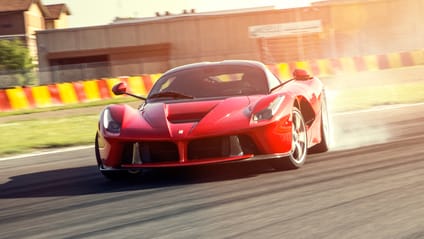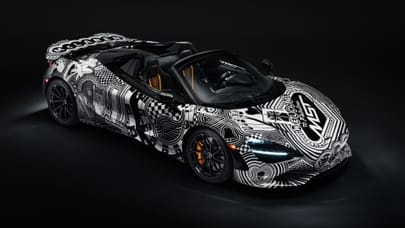
Ferrari's greatest cars under Amedeo Felisa
Here are the outgoing Ferrari boss's finest supercars. Time to pick a favourite


Amedeo Felisa left Alfa Romeo to join Ferrari as technical director in 1990. It was a dark time for the world’s most famous car company, but he helped turn the ailing ship around. CEO since 2008, his long-rumoured retirement was confirmed this week, although we hear that he’ll be consulting with Ferrari on future projects. TG.com salutes one of the finest automotive engineers the world has ever seen.
Advertisement - Page continues below456 GT (1992)

The first new Ferrari to arrive following the return of Crown Prince Luca di Montezemolo, the 456 replaced the unloved (though not by TG.com) 412, and did a vastly better job of joining the dots all the way back to the Daytona as far as aristocratic, front-engined V12 Ferrari GTs were concerned. Power came from a new 440bhp 5.5-litre V12, harnessed to a rear transaxle and kept in check by a new electronic damper system, all clothed in a Pininfarina shape that emphasised crisp Italian tailoring over louch Miami Vice extroversion. It was a four-seater, too, and had a decent boot. About half of the cars produced featured a six-speed manual ’box, which makes it seem like a relic from a bygone age. But a good one.
F355 (1994)

Proof of Felisa’s genius came with the F355, which reworked the, ahem, unimpressive 348 into the first 24-carat gem of the modern Ferrari era. The styling overhaul was dramatic enough, but – not for the first time – this was a Ferrari dominated by its engine: in this instance, a 3.5-litre, 380bhp V8 with a flat-plane crank and five-valves-per-cylinder that invited you to rev it to its 8500rpm red line. As this was 1994, before the days of legislative strangulation, the result is a noise even Ferrari hasn’t quite managed to top in the 22 years since. It was also the first road-going Ferrari to feature the F1 paddleshift, a sure sign of things to come. We appreciated the new technology, but the six-speed manual was and remains the better option.
Advertisement - Page continues below550 Maranello (1996)

Ferrari’s range-topping V12 two-seaters were traditionally front-engined, until 1973’s 365 GTB4 Berlinetta Boxer belatedly moved the power unit to the middle (the link to Formula One was and remains invaluable to Ferrari). The Testarossa that followed in ’84 – though recently re-embraced by Seventies kids with lots of disposable – stuck to the format, but both had tricky on-limit handling ‘foibles’. 1996’s 550 Maranello – pray that Aston Martin doesn’t launch a car called Gaydon – moved the engine back to the front, a reworked version of the 5.5-litre V12 in the 456, with 478bhp and a 7000pm red-line.
"The big challenge was devising a front-engined layout that worked better than the mid-engined configuration," Felisa told me back in 2012. "But the really big step forward was the gearbox. The gearshift in a car with the F1 transmission is so dramatically better because it allows you to push the car as a whole much more. I was initially resistant, because I was a little bit afraid of losing something characteristic of our cars. But it was soon clear this was the way forward."
It was launched at the Nürburgring with Michael Schumacher, midway through his first season with Ferrari, on hand to show off. Despite its size and weight, the 550 Maranello had the handling chops of a much smaller car. It also felt incredibly robust; Montezemolo demanded Ferraris clients could actually use and rely on, and the ingegnere Felisa duly delivered.
Enzo (2002)

Off the back of Schumacher’s imperial phase in F1, the first Ferrari supercar since 1995’s misunderstood (but brilliant) F50 was a monumental engineering statement. An all-new 651bhp 6.0-litre V12 was only part of the deal here; the carbon and aluminium chassis and composite body worked in tandem with the most advanced aerodynamics ever seen on a road car to deliver a Ferrari good enough to wear the name of the original boss (Ferrari Felisa would have had an odd ring to it).
360 Challenge Stradale (2003)

Although there was an ultra-limited track-oriented F355, the 360 CS was the car that kick-started the hardcore Ferrari sub-genre. On the face of it, an extra 20bhp over the stock 360 Modena wasn’t much to write home about, especially for the £30k premium the CS commanded over the standard car when it was new, but don’t be fooled: this is a masterpiece of honed, efficient but red-blooded engineering. The engine and exhaust are practically bespoke, there were carbon brakes and the noise – as ever – is unholy bordering on the illegal. Ferrari made just 852 of these, a fraction of which arrived in the UK.
(NB: there’s a 2000-mile 360 CS for sale in the UK right now – a snip at £325,000. Say no more)
430 (especially Scuderia) (2008)

The Scud made the CS look a bit half-assed. At 1350kg, it was 85kg lighter than the regular 430, lighter too than the Enzo whose performance and savagery the Scuderia replicates. Felisa, the consummate engineer, must have loved the hollow anti-roll bars, the titanium springs, and the stripped cabin. The 430 Scud was also the car that ushered in the new generation E-diff and stability electronics that would go on to revolutionise Ferrari’s road cars. Forget traction control, this was traction optimisation, and the result was a Ferrari that was faster round Fiorano with all the handling controls switched on (well, in Race mode, rather than full CST off), even in the hands of experts.
Advertisement - Page continues below599 (especially GTO)

A true classic, and a bit of a nutter. Ferrari trusts its clients to accept when the limits are being pushed. "Everything we did on the 599XX in terms of the electronic controls we migrated on to the GTO," Felisa told me. "You enjoy this car because you are really driving it. As I have said many times, all our cars should be easy to drive. Except the GTO. This is for special drivers. It is a very serious car." The GTO generates 144kg of downforce at 122mph, twice that of the regular 599. It’s also currently five times as valuable...
458 Italia (especially Speciale)

The last naturally aspirated Ferrari V8, and in Speciale form, it’s arguably one of the greatest Ferraris ever. In terms of the big picture, it delivers 597bhp at 9000rpm, can do 62mph in 3.0 seconds, and has the highest specific output ever achieved by a production engine. But it’s the detail stuff that really blows your mind: the bonnet, for example, uses two layers, one of which is only 0.9mm thick, and has to be super-formed by a company in the UK as a result. The exhaust system has been completely redesigned. And the engineers analysed how the materials used in the chassis behaved, and removed and replaced the bits that didn’t contribute to the car’s overall stiffness. Genius bordering on madness, but the result is a car even Ferrari will be hard-pushed to top.
Advertisement - Page continues belowF12berlinetta

The greatest front-engined Ferrari GT ever. The V12 produces 730bhp and has more performance than any sane human being could possibly want. Now compare it with what Ferrari was doing 25 years ago for an index of the boss’s influence.
LaFerrari

Felisa isn’t a big fan of hybrid technology – it adds weight and complexity, perhaps unnecessarily – but the LaFerrari proves that Ferrari can still do it. Mind-bending.
Trending this week
- Car Review
BMW iX3







